M. V. Dhurandhar
Mahadev Vishwanath Dhurandhar (18 March 1867 – 01 June 1944) was noted Indian painter from the British colonial era.[1] and postcard artist.[2] His illustrations of women of that era doing their daily chores are especially popular.[3]
M. V. Dhurandhar | |
|---|---|
 Self Portrait - Oil painting on canvas by M.V. Dhurandhar, dated 1928. | |
| Born | 18 March 1867 British India |
| Died | 01 June 1944 (aged 77) |
| Nationality | Indian |
| Known for | Painter |
Early life
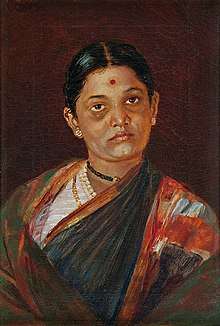
]
Madhav V. Dhurandhar was born in Kolhapur, Maharashtra. He went to Rajaram High School, Kolhapur. He was accepted into J.J. School of Art, Bombay in 1890, and was student of the artist John Griffiths. As a student he won many medals for his work. He graduated in 1895[4]
Career
After graduating from J. J. School of Art, Dhurandhar was offered a position at the same school in 1896 where he spent the rest of his career. In 1910, he was appointed as the Head Master. He was appointed Inspector of Drawing and Craft in 1918 and served in that position until 1931. He was the Vice-Principal for two years before retiring.[5]
Style and Works
His popular works include documenting the city of Bombay and its people, as well as painting scenes from Hindu mythology and Omar Khayyam series.[6] A prolific artist, Dhurandhar is said to have made some thousands of paintings and illustrations, including some that were turned into lithographic prints, such as his illustrations for the book Women of India by Otto Rothfield (1920).[7] Dhurandhar also designed postcards, provided the illustrations for the S. M. Edwardes By-Ways of Bombay (1912) and C. A. Kincaid's Deccan Nursery Tales, besides drawing cartoons for the Gujarati periodicals Aram and Bhoot.[8] He also made religious illustrations published by the Ravi Varma Press. He wrote an autobiography in Marathi about his years at the J.J. School. In 1926, he was commissioned by the ruler of Aundh State, Maharaja Bhawanrao Pantpratinidhi to make paintings on the life of Shivaji.[9]
Paintings
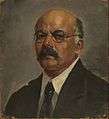 Self Portrait of Painter
Self Portrait of Painter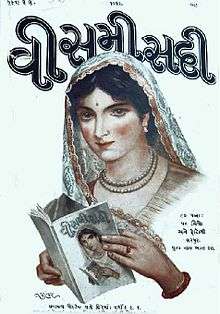 Cover art of 1916 issue of Gujarati magazine
Cover art of 1916 issue of Gujarati magazine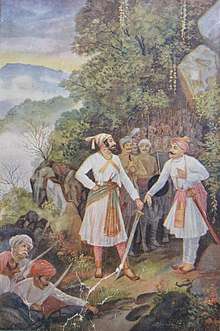 Shivaji Maharaj and Baji Prabhu at Pawan Khind
Shivaji Maharaj and Baji Prabhu at Pawan Khind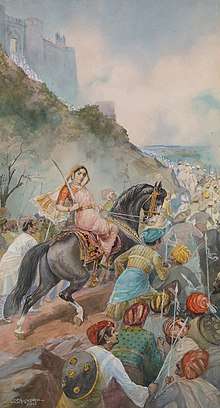 A 1927 depiction of Tarabai in battle.
A 1927 depiction of Tarabai in battle.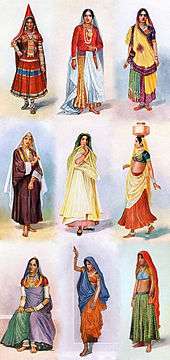 Lengha Choli
Lengha Choli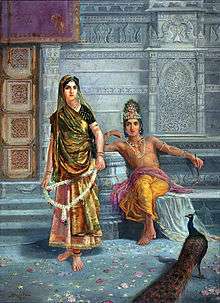 Radha and Krishna
Radha and Krishna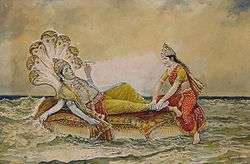 Sheshashayi - Laxminarayan
Sheshashayi - Laxminarayan
References
- "Promoting contemporary art". The Hindu. Chennai, India. 17 January 2008.
- "Women Of India By M.v. Dhurandhar". Archived from the original on 20 January 2016.
- "Still life to move art lovers". The Hindu. Chennai, India. 13 December 2007.
- "Kipling's home may become a museum". The Hindu. Chennai, India. 5 March 2007.
- "Archived copy". Archived from the original on 19 July 2010. Retrieved 24 July 2010.CS1 maint: archived copy as title (link)
- "Array of art".
- "M. V. Dhurandhar". Images of Asia. Archived from the original on 26 March 2012. Retrieved 27 April 2012.
- Partha Mitter (1994). Art and Nationalism in Colonial India, 1850-1922: Occidental Orientations. Cambridge University Press. pp. 91–. ISBN 978-0-521-44354-8. Retrieved 27 April 2012.
- http://ngmaindia.gov.in/pdf/Press-release-of-M-V-dhurandhar-exhibition.pdf
Further reading
- Partha Mitter (1994). Art and Nationalism in Colonial India, 1850-1922: Occidental Orientations. Cambridge University Press. pp. 91–. ISBN 978-0-521-44354-8. Retrieved 27 April 2012.
- Allan Life. "Picture Postcards by M.V. Dhurandhar: Scenes and Types of India-with a Difference," in Visual Resources (XVII, pp. 401–416, 2001).
- Dhurandhar, M. V. "Kalamandirantil Ekechalish Varsham" [Marathi autobiography] Bombay, 1940.
External links
| Wikimedia Commons has media related to M. V. Dhurandhar. |